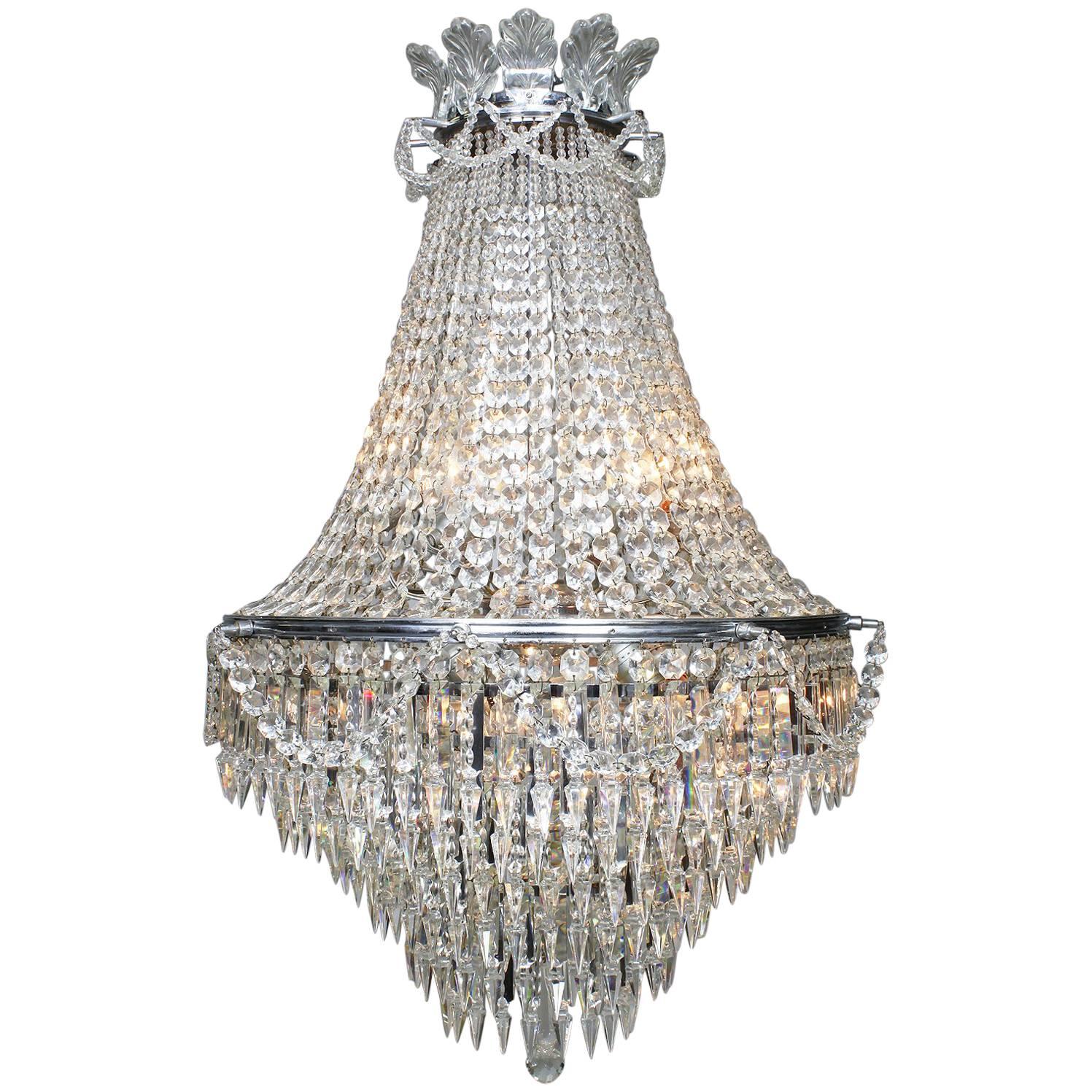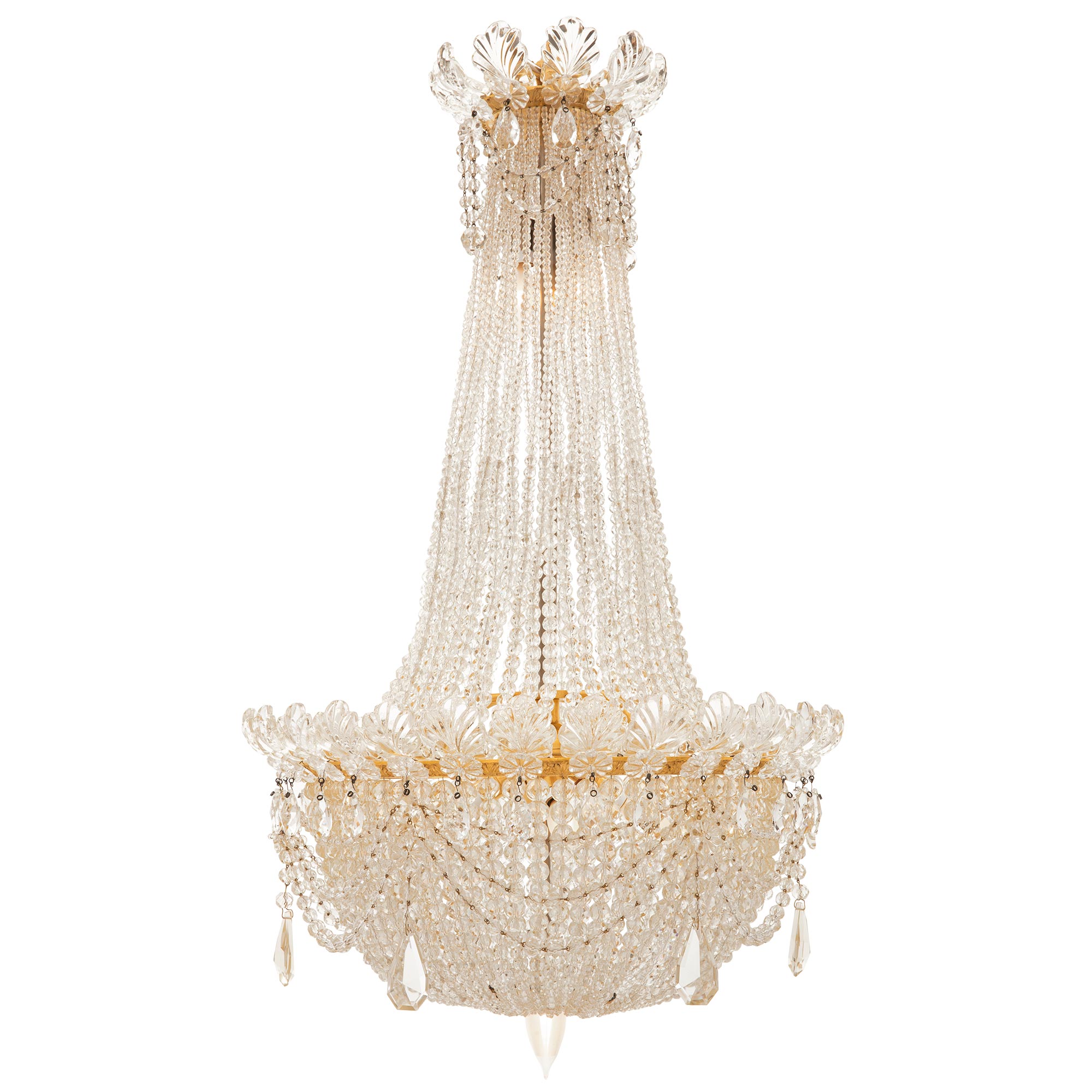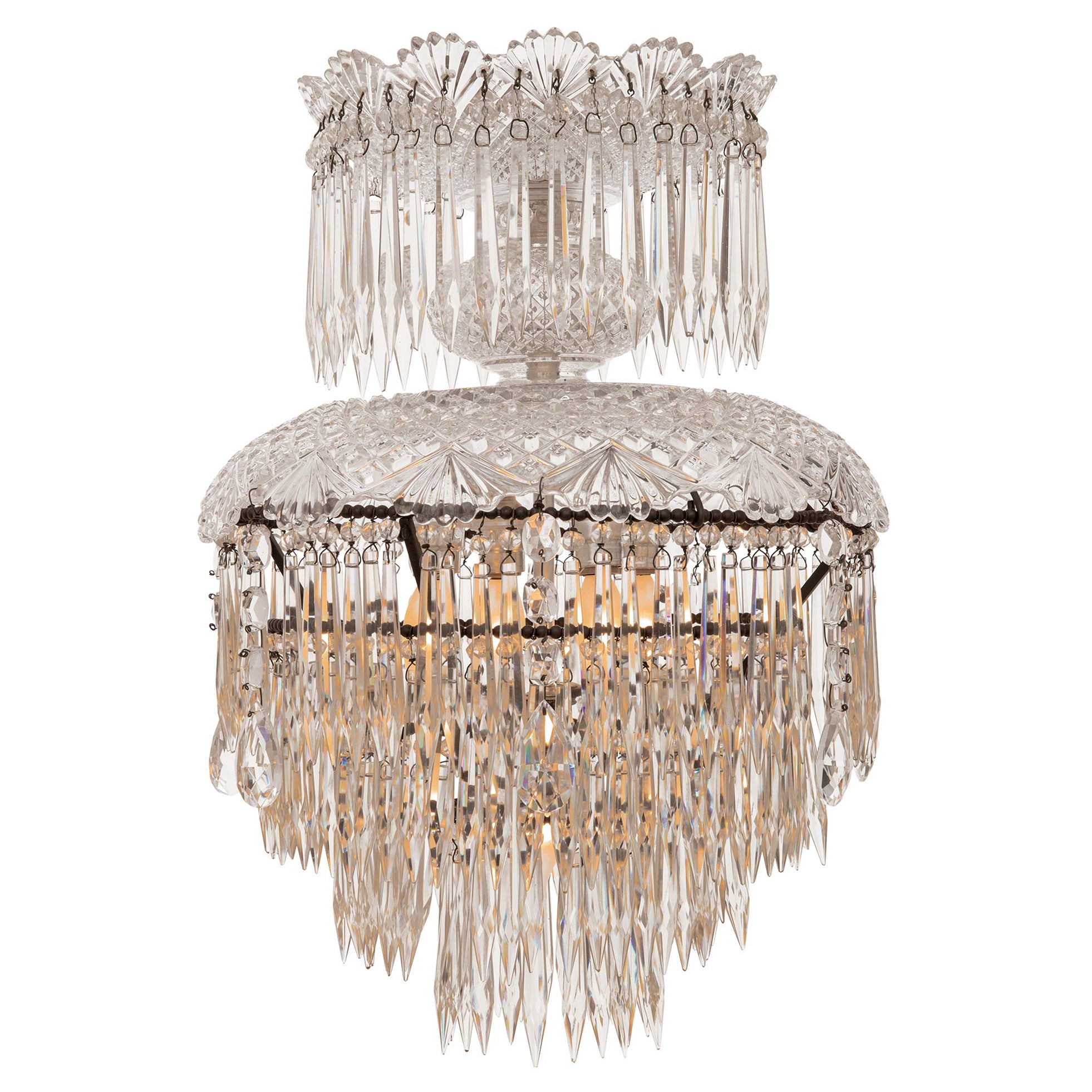Items Similar to 19th Century French Pair of Belle Époque Baccarat Crystal Crinoline Plafonniers
Want more images or videos?
Request additional images or videos from the seller
1 of 8
19th Century French Pair of Belle Époque Baccarat Crystal Crinoline Plafonniers
About the Item
Pair of 19th Century Belle Époque Baccarat Crystal “Crinoline” Plafonniers
Crinoline model created in 1895
Composed of a crown in gilded bronze from which escape long prisms with darts and a cut crystal center piece cup finished with an ormolu pinecone, the top surmounted by a crystal piece as well.
Cristallerie de Baccarat
Circa 1895
This emblematic piece of heritage bathes spaces in a rain of crystal.
Like a luminous architecture, the light transfigures its large prisms into sparkling
stalactites of ice.
Between its unique transparency and its facets treated like thousands of micro-mirrors, the Crinoline chandelier transforms light into a surprise, evolving every second according to the movements of its environment.
Between 1764 and 1860, with rare exceptions, the crystal Manufacture of Baccarat doesn’t sign its works. The first paper labels appear in 1860 and represent inside a circle, a carafe surrounded by a goblet and a cup above which is marked BACCARAT. From 1875, the brand BACCARAT in stick letters and in relief is present on some blown models and on the bronze parts of the mounts. It’s from 1936 that the carafe, surrounded by a goblet and a cup with BACCARAT marked above, appears systematically on the production.
- Creator:Cristalleries De Baccarat (Manufacturer)
- Dimensions:Height: 23.63 in (60 cm)Diameter: 13.78 in (35 cm)
- Sold As:Set of 2
- Style:Napoleon III (Of the Period)
- Materials and Techniques:
- Place of Origin:
- Period:
- Date of Manufacture:circa 1850
- Condition:Wear consistent with age and use.
- Seller Location:Saint-Ouen, FR
- Reference Number:1stDibs: LU2612331207762
About the Seller
4.9
Vetted Seller
These experienced sellers undergo a comprehensive evaluation by our team of in-house experts.
1stDibs seller since 2017
56 sales on 1stDibs
Typical response time: 1 hour
- ShippingRetrieving quote...Ships From: Saint-Ouen, France
- Return PolicyA return for this item may be initiated within 2 days of delivery.
More From This SellerView All
- 19th Century French Lacquered Wood ChandelierLocated in Saint-Ouen, FRA 19th century French polychromed lacquered wood eight-light chandelier Lacquered gloss cream wood with green, red and brown highlights Contained vase ending in foliated seed welcoming eight arms forming semicircles. The top has a frieze of red flowers in green interlacing and is topped with leaves and a painted egg cream...Category
Antique 1890s French Louis XVI Chandeliers and Pendants
MaterialsWood
- French 19th Century Twelve Lights Restauration Period ChandelierLocated in Saint-Ouen, FRA twelve lights green patinated metal, bronze and ormolu restauration period chandelier.Category
Antique 1820s French Restauration Chandeliers and Pendants
MaterialsBronze
- French 19th Century Ormolu Chandelier After André-Charles BoulleBy André-Charles BoulleLocated in Saint-Ouen, FRA Louis XIV style ormolu eight-lights chandelier, after the famous model by Andre-Charles Boulle An Ormolu Eight-lights Chandelier, each arm held by Ind...Category
Antique 1870s French Louis XIV Chandeliers and Pendants
MaterialsOrmolu
- French 19th Century Pair of Porcelain Cache-PotsLocated in Saint-Ouen, FRPair of polychromed hand painted porcelain with Japonisme floral decoration Ormolu-mounted with open-worked base and rim Louis XVI Style circa 1880.Category
Antique 1870s French Chinoiserie Planters, Cachepots and Jardinières
MaterialsOrmolu
- A Very Fine Quality 19th Century French Pair of CandlesticksLocated in Saint-Ouen, FRVery Fine French 19th Century Pair of Candlesticks In ormolu, very finely chiseled and decorated with knotted garlands, branches of leafy flowers, spokes of hearts, leaves of water...Category
Antique 1870s French Louis XVI Candlesticks
MaterialsOrmolu
- French 19th Century Pair of Lacquered Bamboos Japonisme VasesBy Ferdinand Barbedienne, Edouard LievreLocated in Saint-Ouen, FRA 19th French century pair of Lacquered Bamboos Japonisme vases. An amazing pair of tall cylindrical bamboo vases decorated in Japanese Gold and Sil-ver Hiramaki-E Lacquer with Pavilions in The Mist and Weaving Figures, Flown Over by a Pair of Cranes. Enclosed in a Sino-Japanese Inspiration Golden and Brown Patina Bronze Mount Featuring Elephant Heads, Partially Openwork Branches and Salamanders Forming Side Handles. Circa 1870 Attributed to Édouard Lièvre (1828-1886) and Ferdinand Barbedienne (1810-1892) Édouard Lièvre (1828-1886) is one of the most talented and prolific designer and industrialist of the 19th Century, his repertoire is sometimes Sino-Japanese or Neo-Renaissance, whether in furniture or works of art, we can note in particular the parade bed of Valtesse de La Bigne, furniture commissioned by the painter Édouard Detaille or even Sarah Bernhardt, and the famous works in collaboration with Maison Christofle or those in gilded bronze and cloisonné enamel edited by Ferdinand Barbedienne, presented at the Universal Exhibitions in 1878, 1889 and 1900. He was both a draftsman, painter, illustrator, engraver, ornamentalist and cabinetmaker, first trained in the studio of the painter Thomas Couture, Lièvre was then fully immersed in the world of decoration, creation and ornamentation and provides designs for manufacturers and merchant-publishers. Often assisted by his brother Justin, he first produced works of art for his own apartment, seeking out the finest craftsmen to execute his designs for bronzes, ceramics, fabrics and luxury furniture from great virtuosity and great taste. He then collaborated with the cabinet-maker Paul Sormani, as well as haberdasher merchants such as the Escalier de Cristal, bronziers such as Maison Marnyhac and especially Ferdinand Barbedienne as on our vases with bronze mounts characteristics of Edouard Lièvre's work. Born in 1810, died in Paris in 1892, Ferdinand Barbedienne, the most important caster of bronze pieces of art during the second half of the 19th Century, created and directed in Par-is one of the major artistic foundries of his time. Barbedienne specialized in classical reproductions, whose models were exposed in famous European museums. Their illustrated catalogues included many diverse objects such as busts, ornemental sculpture (clocks, candelabras, cups) sometimes even life-sized and bronzes for furniture. Apart from his own produc-tion, Barbedienne worked for the most renowned sculptors such as Barrias, Clésinger and Carrier-Belleuse. All his works were highly esteemed and he, himself honored by contemporary critics. At the London exhibition in 1851 Barbedienne’s firm won two « Council medals ». At the 1855 Universal Exhibition, he won a medal of honor. The success of Barbedienne’s firm brought him many official commissions, such in about 1860, as Barbedienne supplied bronzes for furniture for the Pompeian Villa of Prince Napoléon-Joseph, located avenue Montaigne in Paris. At the London Universal Exhibition of 1862 Barbedienne won medals in three different categories: Furniture, Silversmith work and Artistic bronzes. Barbedienne was made an officer of the Légion d’Honneur in 1867 and Commander in 1878 when he was compared with « a prince of industry and the king of bronze casting ». His glory did not decline with the passage of the time for at the Universal Exhibition of 1889 the critics thanked Barbedienne for the example he set for other bronze-casters by the perfection of his bronzes. “Japonisme” in the second half of the 19th century, was a craze for everything that came from Japan or imitated its style. The word was first coined in a series of articles published by Philippe Burty, from May 1872 to February 1873, in the French magazine “la Renaissance Littéraire et Artistique”. Far from the Academic sphere, artists seeking for new ways of expression, appropriated this discovery. Manet and the impressionists led the way to half a century of enthusiasm for Japanese art, and largely contributed to the esthetical revolution Europe experienced between 1860 and the beginning of the twentieth century. From 1862, The World’s Fairs provoked massive arrivals of fans, kimonos, lacquers, bronzes, silks, prints and books that launched the real era of Japonisme. With those exhibitions, the demand was boosted, the number of merchants and collectors was multiplied, and artists became passionate about this new esthetic. For them, its “primitivism” was probably its most important quality: artists were fond of the Japanese art’s capacity to be close to nature and to reconcile art and society by representing, with a lot of care, the most trivial objects. In painting, Edouard Manet, Mary Cassatt, Degas, Van Gogh, Gauguin were among those who were deeply inspired by Japanese art, affected by the lack of perspective and shadow, the flat areas of strong color, the compositional freedom in placing the subject off-center, with mostly low diagonal axes to the background. The Japanese iris, peonies, bamboos, kimonos, calligraphy, fish, butterflies and other insects, the blackbirds, cranes and wading birds, the cats, tigers, and dragons were endless sources of inspiration, appropriation, and reinterpretation for European artists. The occidental productions were combining styles and artistic conceptions instead of copying Japanese art slavishly. That is what brings to light the comparison between the artworks of Kitagawa Utamaro and Degas, of Katsushika Hokusai and Van Gogh The World’s Fairs of 1851 and 1862 in London, those of 1867, 1878, 1889 and 1900 in Paris, of 1873 in Vienna and of 1904 in Saint Louis presented a number of “Japanese-Chinese” installations with earthenware, bronzes, screens and paintings and attracted the largest amounts of visitors In Vienna, the “Japanese village...Category
Antique 1870s French Japonisme Vases
MaterialsBronze
You May Also Like
- French Belle Epoque 19th-20th Century Cut-Glass Chandelier, Baccarat AttributedBy Cristalleries De BaccaratLocated in Los Angeles, CAA very fine French Belle Époque 19th-20th century cut-glass cascade and silver plated bronze ten-light chandelier, attributed to Baccarat, Paris, circa 1900. Measures: Height 35 1/2...Category
Antique Early 1900s French Belle Époque Chandeliers and Pendants
MaterialsBronze
- French 19th Century Belle Époque Period Ormolu And Baccarat CrystalLocated in West Palm Beach, FLA stunning French 19th century Louis XVI st. Belle Époque period ormolu and Baccarat crystal chandelier. The four arm eight light chandelier is centered by an elegant bottom crystal ball amidst an exceptional array of seashell, teardrop, and kite shaped crystal pendants leading up the cage. The four elegantly scrolled arms display fine acanthus leaves and lovely foliate and tied ribbon bobeches below fluted floral candle cups and are each separated by striking impressive crystal daggers and additional teardrop shaped crystal pendants. The beautifully shaped cage centers four unique smaller curved arms with inverted light...Category
Antique 19th Century French Louis XVI Chandeliers and Pendants
MaterialsCrystal, Ormolu
- French 19th Century Belle Époque Period Ormolu and Baccarat Crystal ChandelierLocated in West Palm Beach, FLA sensational and most unique French 19th century Louis XVI st. Belle Époque period ormolu and Baccarat crystal birdcage shaped chandelier. The charming eight arm twelve light chande...Category
Antique 19th Century French Belle Époque Chandeliers and Pendants
MaterialsCrystal, Ormolu
- French 19th Century Belle Époque Period Ormolu And Baccarat Crystal ChandelierLocated in West Palm Beach, FLA very attractive French 19th century Belle Époque Period Louis XVI st. Ormolu and Baccarat crystal chandelier. The six arm, nine light chandelier is centered by a stunning facetted ...Category
Antique 19th Century French Belle Époque Chandeliers and Pendants
MaterialsCrystal, Ormolu
- French 19th Century Belle Époque Period Baccarat Crystal and Ormolu ChandelierLocated in West Palm Beach, FLA stunning and extremely decorative French 19th century Louis XVI st. Belle Époque period Baccarat crystal and ormolu chandelier. The seven light chandelier is centered by a unique hanging central light bulb surrounded by a lovely richly chased wrap around foliate ormolu band and beautiful beaded garlands...Category
Antique 19th Century French Louis XVI Chandeliers and Pendants
MaterialsCrystal, Ormolu
- French 19th Century Louis XVI St. Baccarat Crystal Plafonnier ChandelierLocated in West Palm Beach, FLAn exquisite and high quality French 19th century Louis XVI st. Baccarat Crystal plafonnier chandelier. This truly stunning five light plafonnier is centered by a circular band of ha...Category
Antique 19th Century French Louis XVI Chandeliers and Pendants
MaterialsCrystal
Recently Viewed
View AllMore Ways To Browse
Crystal Center Piece
Antique Model T
Baccarat Crystal Pendant
French Crystal Chandelier Baccarat
Baccarat Chandelier Pendant Crystal
Crystal Circle
Large Prism
19th Century Pair Of Chandeliers
Antique Lighting Architectural Antiques
Architectural Antique Lighting
Belle Epoque Light
Pair Of Baccarat
Used Crinoline
Antique Baccarat Chandeliers
Antique Baccarat Chandelier
Baccarat Chandelier Antique
Baccarat Antique Chandelier
Antique French Letters





